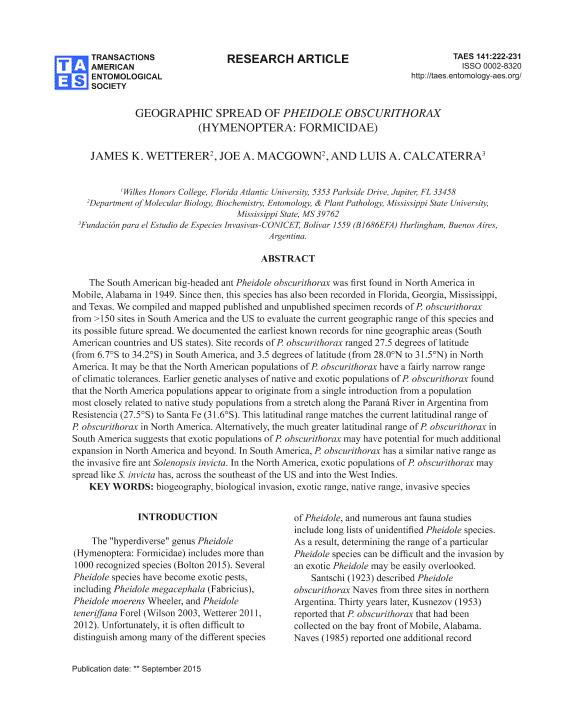Mostrar el registro sencillo del ítem
dc.contributor.author
Wetterer, James K.
dc.contributor.author
MacGown, Joe A.
dc.contributor.author
Calcaterra, Luis Alberto

dc.date.available
2018-04-12T17:26:06Z
dc.date.issued
2015-01
dc.identifier.citation
Wetterer, James K.; MacGown, Joe A.; Calcaterra, Luis Alberto; Geographic Spread of Pheidole obscurithorax (Hymenoptera: Formicidae); American Entomological Society; Transactions of the American Entomological Society; 141; 1; 1-2015; 222-231
dc.identifier.issn
0002-8320
dc.identifier.uri
http://hdl.handle.net/11336/41859
dc.description.abstract
The South American big-headed ant Pheidole obscurithorax was first found in North America in Mobile, Alabama in 1949. Since then, this species has also been recorded in Florida, Georgia, Mississippi, and Texas. We compiled and mapped published and unpublished specimen records of P. obscurithorax from >170 sites in South America and the US to evaluate the current geographic range of this species and its possible future spread. We documented the earliest known records for nine geographic areas (South American countries and US states). Site records of P. obscurithorax ranged 27.5 degrees of latitude (from 6.7°S to 34.2°S) in South America, and 3.5 degrees of latitude (from 28.0°N to 31.5°N) in North America. It may be that the North American populations of P. obscurithorax have a fairly narrow range of climatic tolerances. Earlier genetic analyses of native and exotic populations of P. obscurithorax found that the North America populations appear to originate from a single introduction from a population most closely related to native study populations from a stretch along the Paraná River in Argentina from Resistencia (27.5°S) to Santa Fe (31.6°S). This latitudinal range matches the current latitudinal range of P. obscurithorax in North America. Alternatively, the much greater latitudinal range of P. obscurithorax in South America suggests that exotic populations of P. obscurithorax may have potential for much additional expansion in North America and beyond. In South America, P. obscurithorax has a similar native range as the invasive fire ant Solenopsis invicta. In the North America, exotic populations of P. obscurithorax may spread like S. invicta has, across the southeast of the US and into the West Indies.
dc.format
application/pdf
dc.language.iso
eng
dc.publisher
American Entomological Society

dc.rights
info:eu-repo/semantics/openAccess
dc.rights.uri
https://creativecommons.org/licenses/by-nc-sa/2.5/ar/
dc.subject
Biogeography
dc.subject
Biological Invasion
dc.subject
Exotic Range
dc.subject
Native Range
dc.subject.classification
Otras Ciencias Biológicas

dc.subject.classification
Ciencias Biológicas

dc.subject.classification
CIENCIAS NATURALES Y EXACTAS

dc.title
Geographic Spread of Pheidole obscurithorax (Hymenoptera: Formicidae)
dc.type
info:eu-repo/semantics/article
dc.type
info:ar-repo/semantics/artículo
dc.type
info:eu-repo/semantics/publishedVersion
dc.date.updated
2018-04-12T14:31:17Z
dc.journal.volume
141
dc.journal.number
1
dc.journal.pagination
222-231
dc.journal.pais
Estados Unidos

dc.description.fil
Fil: Wetterer, James K.. Mississippi State University; Estados Unidos
dc.description.fil
Fil: MacGown, Joe A.. Mississippi State University; Estados Unidos
dc.description.fil
Fil: Calcaterra, Luis Alberto. Fundación para el Estudio de Especies Invasivas; Argentina. Consejo Nacional de Investigaciones Científicas y Técnicas; Argentina
dc.journal.title
Transactions of the American Entomological Society

dc.relation.alternativeid
info:eu-repo/semantics/altIdentifier/url/http://www.bioone.org/doi/abs/10.3157/061.141.0113
dc.relation.alternativeid
info:eu-repo/semantics/altIdentifier/doi/http://dx.doi.org/10.3157/061.141.0113
Archivos asociados
